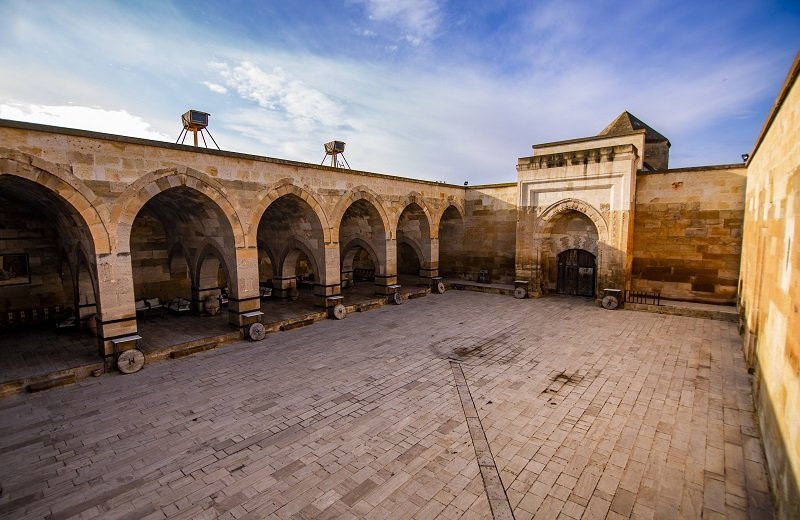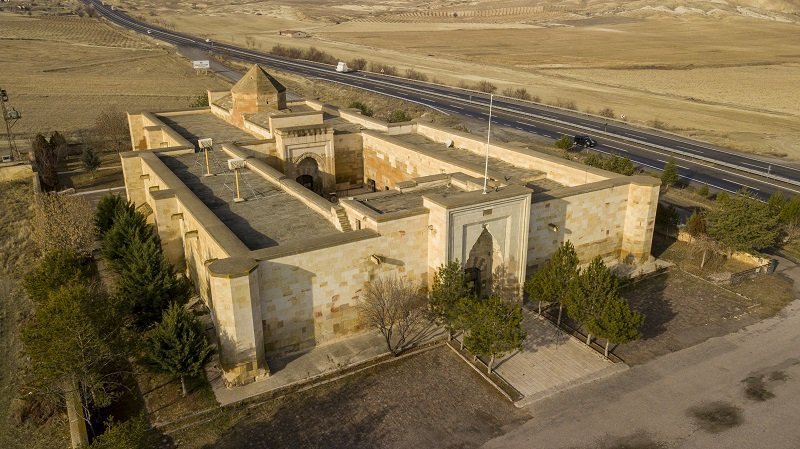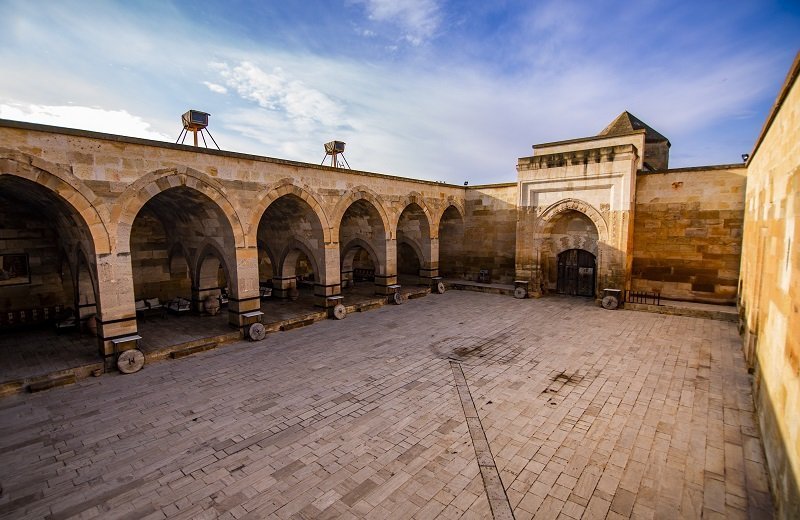Duration
2 Hours
Group size
24 people
Location
Cappadocia
Whirling Derviches Ceremony
Whirling Dervishes ceremonies start at 18:00 in winter and 21:00 every night. The whole ceremony takes around one hour. Turkish Heritage Travel picks you up from your hotel in Goreme or other towns of Cappadocia half an hour earlier, which will give you enough time to see the parts of the caravanserai prior to ceremony.
We offer free pick-up/drop-off service for all the hotels. It is forbidden to take pictures during the ceremony. Email us to book the famous Whirling Dervish ceremony.
HISTORY & INFORMATION ABOUT THE WHIRLING DERVISHES CEREMONY
Sema is is the inspiration of Mevlânâ Celâleddin-i Rumî (1207 - 1273) as well as part of Turkish custom, history, beliefs and culture It symbolizes in seven parts the different meanings of a mystic cycle to perfection (Ascension - Mirac). Contemporary science definitely confirms that the fundamental condition of our existence is to revolve. There is no object, no being which does not revolve and the shared similarity among beings is the revolution of the electrons and protons in the atoms, which constitute the structure of the smallest particle to the stars far in the sky. As a consequence of this similarity, every thing revolves and man carries on his life, his very existence by means of the revolution in the atoms, structural elements in his body, bye the circulation of his blood, bye his coming from the Earth and return to it, by his revolving with the Earth itself.
However, all of these are natural, unconscious revolutions. But man is the processor of a mind and intelligence which distinguished him from and makes him superior to other beings
Thus the whirling dervish or Semâzen causes the mind to participate in the shared similarity and revolution of all other beings.
- The Semâ ceremony represents all a mystical journey of man's spiritual ascent through love, deserts his ego, finds the truth and arrives to the Perfect. Then he returns from this spiritual journeys as a man who reached maturity and a greater perfection, so as to love and to be of service to the whole creation, to all creatures without discriminating in regard to belief, class, or race The dervish with his head-dress(his ego's tombstone), his white skirt (his ego's shroud) is spiritually born to the truth, by removing his black cloak, he journeys and advances to spiritual maturity through the stages of the Semâ. At the onset and each stage of the Semâ holding his arms crosswise he represents number one, and testifies to God's unity. While whirling his arms are open, his right hand directed to the sky ready to receive God's beneficence, gazing his left hand turned toward the earth, he turns from right to left, pivoting around the heart. This is his way of conveying God's spiritual gift to the people upon whom God looks with a Divine watchfulness. Revolving around the heart, from right to left, he embraces all of humankind, all the creation with affection and love.
The Semâ is consisted of several parts, with different meanings
A- It stars with a eulogy Nat-ı Şerif to the Prophet, who represents love, an all Prophets before him. To praise them is praising God, who created all of them.
B- This eulogy is followed by a drum sound symbolising the Divine order of the Creator.... 'Kun=Be!'
C- Then follows an instrumental music improvisation ' taksim ' with a read ' ney ', it represents the firts breath which gives life to everthing : The Divine Breath.
D- The fourth part is the dervishes gretings to each other and their thirice repeated circular walk 'Devri Veledi' accompanied by music called 'peshrev', it symbolize the salulation of soul to soul concealed by shapes and bodies.
E- The fifth part is the Semâ (whirling) it concists of four salutes or 'Selam's. At the end of each as in the onset, the dervish testifies by appearance to God's unity.
1- The first salute is man's birth to truth by feelingand mind. It represent his complete conception of the existance of God as Creator and his own state of creature.
2- The second salute expresses the rapture of man witnessin the splendor of creation, in front of God's greatness and omnipotence.
3- The third salute is the dissolution rapture into love and there by the sacrifice of mind to love. It is a complete submission, it is the annihilation of self in the loved One, it is unity. This state of ecstasy is the highest grade defined as 'Fenafillah' in İslâm. However, the highest rank in İslâm is the rank reached by the Prophet : He is called God's servant foremost and subsequently his messenger. The aim of Semâ is not unbroken ecstasy and loss of concious thought, but realization of.
4- The fourt salute: Just as the Prophet ascends the 'Throne' and then returns to his task on earth, the whirling dervish, folloving the termination of his spiritual journey and his ascent, returns to his task, to his state of subservience. (He is a servant of God, of His prophets and all the creation...) Sura Bakara 2, verse 285. At the end of this salute, he demonstrate this again by his apperance, arms placed crsswise representing the of God, conscjously and feelingly.
F- The sixth part of the Semâ is a reading of the Quaran, especialy of the verse from Sura bakara 2, verse 115. (Onto God belong the East and the West, and wherever you turn, there is GOD's countenance. He is All-Embracing. All-Knowing).
G- The Semâ ceremony ends with a prayer for the peace of the souls of all Prophets and all believers... After the completion of 'Semâ' ritual all the dervishes return silently to their cells meditation (tefekkür)..
Mevlana and Mevlevi Order
Mevlana's life is described in Shams ud-Din Ahmad Aflāki's "Manākib ul-Ārifīn" (written between 1318 and 1353). He is described as a descendant of the caliph Abu Bakr, and of the Khwārizm-Shāh Sultān Alā ud-Dīn bin Takash (1199–1220), whose only daughter, Mālika-ye Jahān, had allegedly been married to Rumi's grandfather. However, both claims are rejected by modern scholars.
When the Mongols invaded Central Asia sometime between 1215 and 1220, his father (Baha' ud-Din Walad, a theologian, jurist and a mystic of uncertain lineage) set out westwards with his whole family and a group of disciples. On the road to Anatolia, Rumi encountered one of the most famous mystic Persian poets, Attar, in the city of Nishapur, located in what is now the Iranian province of Khorāsān. 'Attar immediately recognized Rumi's spiritual eminence. He saw the father walking ahead of the son and said, "Here comes a sea followed by an ocean." He gave the boy his Asrarnama, a book about the entanglement of the soul in the material world. This meeting had a deep impact on the eighteen-year-old Rumi's thoughts, which later on became the inspiration for his works.
From Nishapur, Walad and his entourage set out for Baghdad, meeting many of the scholars and Sufis of the city. From there they went to the Hejaz and performed the pilgrimage at Mecca. It was after this journey that most likely as a result of the invitation of 'Alā' ud-Dīn Key-Qobād, ruler of Anatolia, Baha' ud-Din came to Asia Minor and finally settled in Konya in Anatolia within the westernmost territories of Seljuk Empire.
Baha' ud-Din became the head of a madrassa (religious school) and when he died Rumi succeeded him at the age of twenty-five. One of Baha' ud-Din's students, Sayyed Burhan ud-Din-e Muhaqqiq, continued to train Rumi in the religious and mystical doctrines of Rumi's father. For nine years, Rumi practiced Sufism as a disciple of Burhan ud-Din until the latter died in 1240-1. During this period Rumi also travelled to Damascus and is said to have spent four years there.
It was his meeting with the dervish Shams-e Tabrizi in the late fall of 1244 that changed his life completely. Shams had traveled throughout the Middle East searching and praying for someone who could "endure my company". A voice came, "What will you give in return?" "My head!" "The one you seek is Jalal ud-Din of Konya." On the night of December 5, 1248, as Rumi and Shams were talking, Shams was called to the back door. He went out, never to be seen again. It is believed that he was murdered with the connivance of Rumi's son, 'Ala' ud-Din; if so, Shams indeed gave his head for the privilege of mystical friendship.
Rumi's love and his bereavement for the death of Shams found their expression in an outpouring of music, dance and lyric poems, Divan-e Shams-e Tabrizi. He himself went out searching for Shams and journeyed again to Damascus. There, he realized:
Why should I seek? I am the same as
He. His essence speaks through me.
I have been looking for myself!
For more than ten years after meeting Shams, Mawlana had been spontaneously composing ghazals, and these had been collected in the Divan-i Kabir. Rumi found another companion in Salaḥ ud-Din-e Zarkub, the goldsmith. After Salaḥ ud-Din's death, Rumi's scribe and favorite student Hussam-e Chelebi assumed the role. One day, the two of them were wandering through the Meram vineyards outside of Konya when Hussam described an idea he had to Rumi: "If you were to write a book like the Ilāhīnāma of Sanai or the Mantiq ut-Tayr of 'Attar it would become the companion of many troubadours. They would fill their hearts from your work and compose music to accompany it."
Rumi smiled and took out a piece oWhirling Dervishes ceremonies start at 18:00 in winter and 21:00 every night. The whole ceremony takes around one hour. Turkish Heritage Travel picks you up from your hotel in Goreme or other towns of Cappadocia half an hour earlier, which will give you enough time to see the parts of the caravanserai prior to ceremony.
Includes
- Pick-up & Drop-off From / To Hotel










